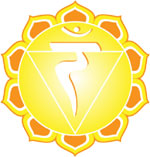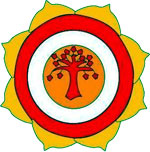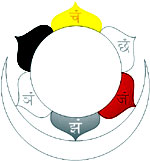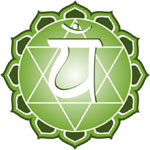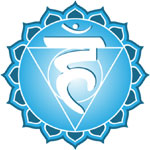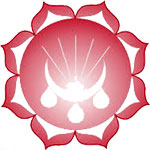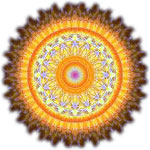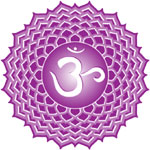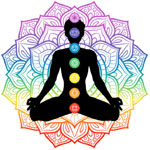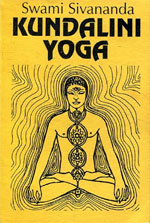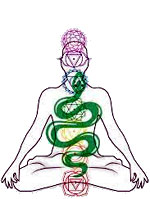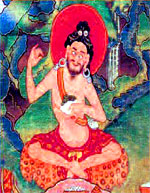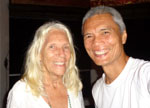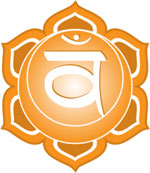
Chakras
Kundalini Blogs
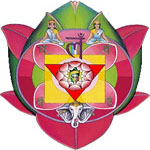 Apr 26, 2020
Apr 26, 2020(updated Jun 23, 2021 Chiang Mai)
Muladhara (root chakra)
Features
- Mantra - LAM
- Vayu (energetic wind) - Apana Vayu (energy residing in the pelvic region, responsible for elimination)
- Mudra - Prithvi mudra (thumb and ring fingers touch)
- Element - earth
- Physical representation - perineum
- Location - at the base of the spine, between the genitals and anus
- Human Traits - grounding, body toughness, resilience, survival instinct, trust, and safety
- Asana - asanas where Mula Bandha can be engaged like pelvic lifts (Malasana, Low Lunge, Warrior I, Warrior II, Goddess, Purvotanasana, Setu Bandhasana )
- Form - lotus flower with 4 red petals bearing the Sanskrit letters va, scha, sha and sa. There is an inverted triangle within the lotus and inside this triangle is the Kundalini shakti - shaped like a serpent, coiled 3.5 times facing down, sleeping
- Statement - "I need to survive - food, clothing and shelter"
- Blocked by - fear (know your fear and transcend or conquer it to open up this chakra)
Muladhara (root chakra)
The Muladhara Chakra is represented by a red 4-petaled lotus flower next to the rectum towards the spinal tip. It's associated mantra is LAM.

Foundational Chakra
Muladhara is also the root chakra and provides foundation for all the chakras - best to start developing this chakra before all the others. Analogy: in a building, the foundation has to be done first. The depth and strength of the foundation dictate the stability of the building. Traditionally, the yogis develop the Muladhara before the other chakras. However, in the last decade of paradigm-shifting where new flavors of the month are in vogue, there has been a push for the Ajna Chakra first - this is a big mistake according to the old school yogis.
Primal Instinct
Our primal instinct where our animal fight-or-flight response is centered here. Pranayama focused on the Muladhara develops vigor and body hardness against life's challenges. In Maslow's hierarchy of needs, survival first (food, clothing and shelter) before heaven in our minds.
Ancestral Transcript
Our accumulated karmic balance sheet (debts and merits) are stored here. This is where we keep records of our ancestral lineage and together with their survival accounts that make our genetic mold.
What are you Afraid of?
The activation of the Muladhara Chakra is blocked by fear. It is important to understand what your fears are. Afraid of losing your fitness and become debilitated? Afraid of rejection by the opposite sex? Afraid of being outsmarted? Whatever those fears are, flush them down. When you become aware of them, they have already served their purpose and need to be expunged from your system. Then the Muladhara Chakra opens up, clearing the way to the higher chakras.
Awakening Kundalini Shakti from Muladhara Chakra
Pranayama to Awaken the Kundalini from the Muladhara Chakra
This exercise (sadhana) is an amalgamation of full lotus seated pose (padmasana), regulated breathing (pranayama), visualization into existence (bhavana), and breath-hold on the inhalation (puraka kumbhaka) and energy locks (kumbhaka).
In Padmasana facing east or north, holding the Prithvi Mudra (thumb and ring fingers touch...fire and earth), set your intention and focus on the Muladhara Chakra. Chant LAM slowly on the exhale and empty your lungs. Now, inhale slowly while visualizing the awakening of the Kundalini Shakti in the Muladhara Chakra. As you continue the inhalation, clearly visualize the Kundalini finding its way up, chakra by chakra, along the central energy channel (Sushumna). Synchronize the breathing so that by the time the lungs are fully inflated, the Kundalini is on the very top chakra, the Sahasrara chakra. Hold the breath in, suck-in the tummy (Uddiyana Bandha), chin to the chest (Jalandara Bandha), and visualize the entire body covered in white light, power and wisdom as you enter the state of Brahmaguna (a state of being in alignment with the universe). AS you exhale, slowly chant LAM while visualizing the Muladhara chakra. At this point, the lungs should be fully empty with no residual air. Repeat the process. This process will hasten the awakening of the Kundalini.
Meditation to Awaken the Kundalini from the Muladhara Chakra
In Padmasasa or Siddhasana, I begin my regular breathing to get settled - for a minute. In Prithvi mudra (thumb + ring fingers), I inhale focusing prana converging on the Muladhara chakra (imagine a lotus flower with 4 red-colored petals). I hold the inhale with a very slight Mula bandha, slight Jalandhara bandha and Nabho mudra (just very mild because this is a meditation and not a bandha workout) and imagine the Kundalini shakti awakening - the coiled serpent wakes up and straightens itself. White light illuminates from the serpent and it illuminates the entire body. I chant LAM repeatedly in my head and heart, cultivating Bhavana (a feeling and thought). When I need to exhale, I let go of the bandhas and imagine Kundalini reverting back to its coiled slumber as I exhale to neutral (not empty). I pause before repeating the process. 10 minutes is fine, but an hour produces a different kind of after-feel.
I might devote the entire day just on Muladhara. On the following day, I go up to Svadisthana - beginning from Muladhara, going up the Sushumna and staying at Svadisthana. This goes on until Kundalini reaches Sahasrara on the 7th day.
Notes on Muladhara Chakra
- Apana - Apana vayu is the energy responsible for elimination of body waste. It resides in the area of the Muladhara, the lower part of the abdomen, descending colon, rectum and anus.
- Prana and Apana - Prana and Apana vayu are united in the Muladhara chakra through Mula Bandha and Uddiyana Bandha. This generates heat which awakens the Kundalini shakti.
- Kundalini - Kundalini Sakti is the dormant serpent power, coiled 3.5 times facing downwards in the Muladhara Chakra, located at the base of the spine. An awakened Kundalini goes up through the Sushumna nadi to the top of the head, the Sahasrara chakra, but may drop down again to Muladhara.
- Pranayama - another way to practise Pranayama to awaken the Kundalini, is to concentrate on the Muladhara Chakra at the base of the spinal column. This is where the Kundalini Sakti resides. Send the nerve-current down the spinal column striking against the Muladhara Chakra, awakening the Kundalini. Kundalini will be awakened quickly if the degree of concentration is intense and if the Pranayama is practised regularly with the prerequisites of yama, niyama and asana.
- Sushumna - Sushumna is the most important of all the energy channels (Nadis). The nerve-current moves through Sushumna in the spinal canal from Muladhara to crown of the head, Sahasrara.
- the body becomes tough
- Laghima siddhi, the body becomes so light it gives rise to levitation
- Darduri siddhi, jumping high and long, up in the air, (simulating flight). This was discussed in detail by Alexandra David-Neel as the Lung-gom-pas, in her book Magic And Mystery In Tibet.
- Trikala jnana, ability to transcend time - present, past and future, memory of past lives
- being disease-free
- Prakamya siddhi / Sankalpa - ability to manifest desires
- Vasitva siddhi - control over the 5 elements - air, fire, ether, earth, water
- Mind control - similar to hypnosis
- Kayakalpa siddhi - slowing down or reversing the aging process by conserving Amrita (the nectar of life)
- sense of smell is heightened
- writing ability is developed
- states of natural ecstacy happens spontaneously
90-Minute Class
- Introduction - What is a chakra? What is Muladhara Chakra? Why do we need to activate? What are the siddhis associated with Muladhara?
- Warm-up - stretches and limbering
- Asana - sqeezing mula bandha on the inhale and releasing on the exhale
- Malasana from Standing - from squatting, pelvic pull on the way up
- Chair from Standing - on reverse prayer hands (optional)
- Pendulum - seated, rock the pelvic floor from side to side
- One-Legged Cradle - seated, cradling one leg at a time
- Pashimotanasana Pelvic Lift - seated with straight legs, straight upright torso and palms pressed by the pelvic side. On the inhale, squeeze mula bandha while hands push against the floor, lifting the pelvic floor up. Exhale, release
- Low Lunge - squeeze on pelvic lift on the way up
- Warrior I - squeeze on pelvic lift on the way up
- Warrior II - squeeze on pelvic lift on the way up
- Goddess - squeeze on pelvic lift on the way up
- Purvotanasana - squeeze on pelvic lift on the way up
- Setu Bandhasana - body arch facing the sky, upper back and heals pressed on the mat, legs are straight
- LAM chanting - seated, inhaling with butt-squeeze, visualizing light moving up, hold 2 seconds, exhaling, release the squeeze, chant LAM very slowly until air runs out. Hold 2 seconds before inhale. 5 minutes.
- Savasana - body scanning, 5 minutes
Muladhara Chakra
CHAKRA: MULADHARA CHAKRA
CHANTING: LAM
a) to start the class, 1 minute composure then 3 mins of LAM chanting - ujjayi breathing on the inhale focusing on the mudra, then LAM chanting on the exhale, shifting focus on the chakra
b) to end the class, 1 minute composure then 3 rounds of LAM chanting - ujjayi breathing on the inhale focusing on the mudra, then LAM chanting on the exhale, shifting focus on the chakra
INTRODUCTION
FULL LECTURE: Muladhara Chakra
Muladhara
<--#include virtual="/yoga_class/c_muladhara.shtml" -->- Statement - "I need to survive - food, clothing and shelter"
- Features
- provides foundation for all the chakras - best to start developing this chakra before all the others
- survival instinct where our animal fight-or-flight response is centered - survival first (food, clothing and shelter) before heaven in our minds
- where we keep records of our ancestral lineage and their survival accounts that make our genetic mold
- Apana vayu, the energy for elimination of waste, resides in the same area as Muladhara. Activating Muladhara allows for optimized elimination
- Muladhara is where the 4 powerful nadis/shakti reside - ida, pingala, sushumna and kundalini. To activate the Muladhara is to energize these etheric elements
- Typical people - every poor person who fights tooth-and-nail for the little morsels thrown their way
- Mantra - LAM
- Sitting Pose - no standard, but Padmasana is ideal
- Asanas - any asana where the pelvis is lifted off the floor
- Pranayama - kundalini rising on the inhale, hold and pressurize, explode on the exhale. Repeat
- Bandha - Mula bandha
- Blockage - fear (what are you afraid of? Know your fear, become aware of them, and face it)
- Activation - chanting LAM, squatting asanas, meditating on muladhara chakra
- Element - earth
- Mudra - Prithvi (earth + fire, ring finger + thumb, helps you gain weight, enhances the physical wellness of the body)
- Warning - if you seem to be too spacey and live 50,000 feet above sea level, you need Muladhara grounding to keep you functional in the real world
- Physical counterpart - perinium muscle at the base of spine (root)
- Location - next to the rectum towards the spinal tip
- Form / Color - lotus flower with 4 red petals. Inside the flower is an inverted triangle with a serpent (kundalini shakti) coiled 3 1/2 times facing downward
- Enhanced Human Qualities
- develops vigor and body toughness to survive the harsh reality of a dog-eat-dog scarcity
- helps you gain weight (if you are too lean)
- Super Human Qualities (Siddhis)
- ability to transcend time - present, past and future (Trikala jnana)
- ability to jump long distances, almost similar to flying (Darduri siddhi, also called Lung-gom-pa in Tibetan yoga)
- gains control over the 5 elements - fire, air, ether, earth and water
- slows down the aging process, promotes long life (Kayakalpa siddhi) by conserving amrita (nectar of immortality)
- Muladhara perspective vs other chakras
note: at this level, you are at the BOTTOM of the barrel
- Muladhara: "I need food clothing and shelter to survive"
- Svadhisthana: "sex, drugs and rock & roll"
- Manipuraka: "I, me, mine - the world is my oyster"
- Anahata: "I have love and compassion"
- Visuddhi: "Instead of fighting with life, I begin to flow with the current of life. I perform at a high level of competence. People naturally move towards me because I can do things beyond their understanding and abilities."
- Ajna: "My intuition is accurate. I have psychic abilities. I see things without the cobwebs and clutter. I see the world in black and white with a very minimal shade of gray (uncertainty, doubt, indecision). Nothing can touch me, nothing can disturb me. But experientially, I still do not feel the spontaneous ecstasy of life."
- Sahasrara: "I am the convergence of energy and consciousness. The self, the universe and God become one"
MUDRA: PRITHVI (Muladhara Chakra)
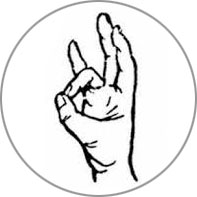
Prithvi Mudra (aka Pruthvi)
Finger Position: thumb and ring finger touch (concentrate on this point), 3 other fingers are together, straightened, then relaxed
Bandha: Mula bandha
Chakra: Muladhara chakra
Elements: earth and fire
Benefits: enhances the physical health of the body, improves personality, helps gain weight (stop when weight has been gained), allows forgive and tolerance
Affected Body Part: entire physical body
Mantra: LAM (Muladhara for body hardness)
Notes: Prithvi mudra is a collective of Muladhara chakra, Mula Bandha, earth element, LAM mantra. They can all be combined in doing asana, pranayama and chanting
ASANA
- Malasana from Standing - from squatting, pelvic pull on the way up
- Chair from Standing - on reverse prayer hands (optional)
- One-Legged Cradle - seated, cradling one leg at a time
- Reverse Table (from seated) - seated with straight legs, straight upright torso and palms pressed by the pelvic side. On the inhale, squeeze mula bandha while hands push against the floor, lifting the pelvic floor up until in Reverse Table Top. Exhale while releasing
- Low to High Lunge - squeeze on pelvic lift on the way up
- Warrior I - squeeze on pelvic lift on the way up
- Warrior II - squeeze on pelvic lift on the way up
- Goddess - squeeze on pelvic lift on the way up
- Purvotanasana - squeeze on pelvic lift on the way up
- Setu Bandhasana (Bridge A & B)
A) squeeze on pelvic lift on the way up, feet and shoulder blades on the floor
B) squeeze on pelvic lift on the way up, curved legs, knees not bent, heels and shoulder blades on the floor, arms reaching up (not propping the pelvic lift) - Setu Bandhasana (advanced Bridge) - legs are NOT bent, pelvis lifted up
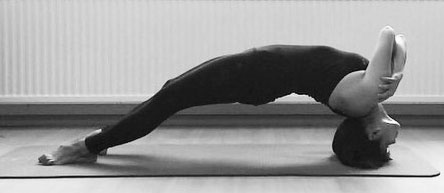 BSetu andhasana (advanced Bridge)
BSetu andhasana (advanced Bridge)
- Aswini Mudra - on Karnapidasana
A. arms straight behind the body with interlaced fingers
B. arms wrapped around the hamstring), inhale, hold the breath and contract/release the anal muscles. Exhale and repeat the process, 5 minutes
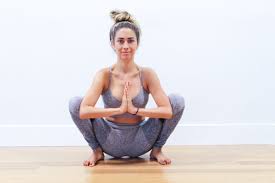
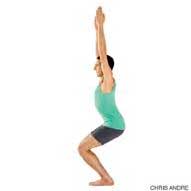
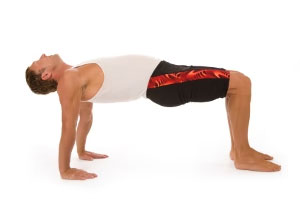
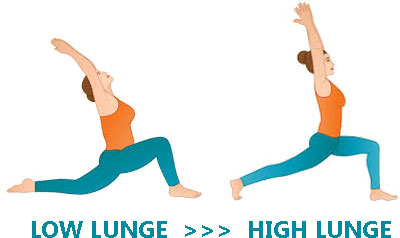
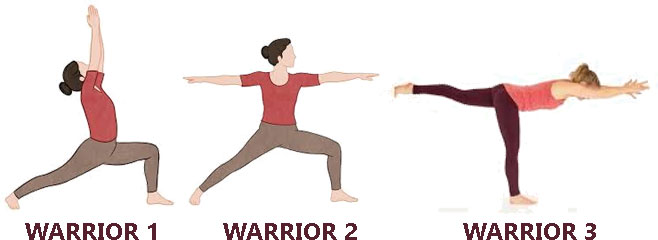
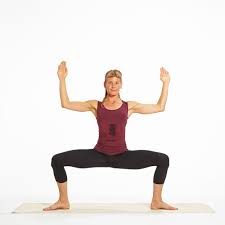
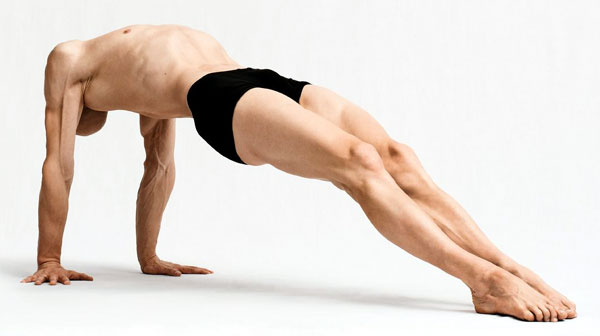

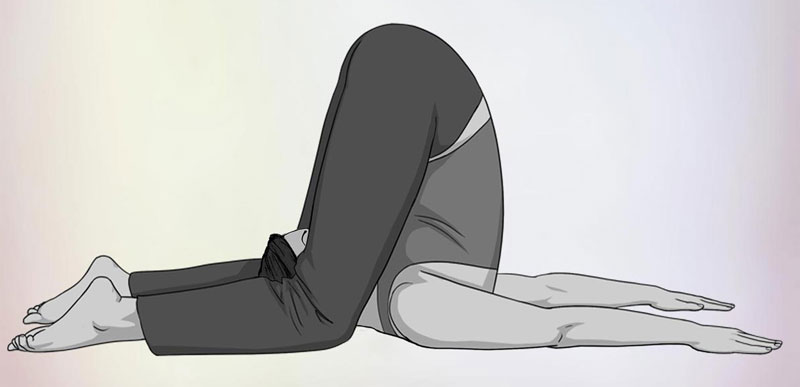
ADDHITTANA
PRANAYAMA
MEDITATION
Focus your attention at the base of your spine where the Muladhara Chakra resides. Envision a lotus flower with 4 red petals. The red petals are spinning consistently...very steady...very smooth...very balanced. Imagine that inside this lotus flower is an triangle facing down. Inside this triangle resides the kundalini shakti, representing by a sleeping serpent coiled 3.5 times with the head facing downward.
With your mental concentration and normal breathing, you are creating heat in the Muladhara Chakra. This heat is awakening the sleeping Kundalini. As it awakes, it straightens itself and goes through that hole of a tube leading up to the top of the head. This tube is the sushumna nadi, the central energy pathway, similar in importance to the spinal cord.
The kundalini shakti begins its journey upwards passing through the essential chakras also lined up along the sushumna. Kundalini passes through the Svadisthana Chakra in the sacral area. The Svadisthana also spins fluidly like the Muladhara chakra. Kundalini continues its journey up passing through the Manipuraka Chakra in the navel area. AS it goes up, it passes through the Anahata chakra at the heart. It reaches the Visuddhi Chakra located on the soft spot on the throat. From there, it reaches up the Ajna chakra or the 3rd eye. Concentrate on this spot between the eyebrows but slightly higher. As we do, we invite grace to come into our lives. Kundalini finally reaches its final destination, the Sahasrara Chakra on top of the head. Here, it radiates into a blinding white light that permeates everything. This white light intensifies and takes over the entire body.
The body is now a blazing white light. This light transcends the body and engulfs the entire space. Everything is white...a blinding white light pervades. And you feel this transcendence. And it takes all over you. As you slowly come out of this meditation, I invite you to see yourself as a divine incarnation...a realized being. Your words are mantra. Your thoughts create reality. What is you feel is infinite oneness. And you carry this with you at all times. The essence of Buddhahood now resides in you.
CHANTING: LAM
a) to start the class, 1 minute composure then 3 mins of LAM chanting - ujjayi breathing on the inhale focusing on the mudra, then LAM chanting on the exhale, shifting focus on the chakra
b) to end the class, 1 minute composure then 3 rounds of LAM chanting - ujjayi breathing on the inhale focusing on the mudra, then LAM chanting on the exhale, shifting focus on the chakra
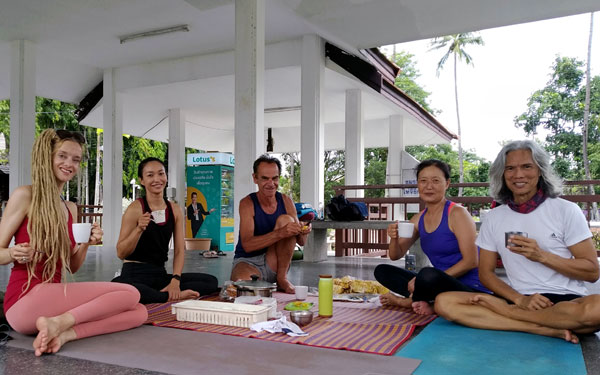
Ending Thoughts
As a grounding chakra, it is relatively easy to spot the Muladhara level of a person. I've met conscious people who seem to live 50,000 feet above sea level and unaware of their spacey state. They are mindful of their breath but miss appointments, meetings and deadlines. Sorry to say, but monks seem to behave like that. Hello from planet Earth! This happens when other chakras were developed first before the Muladhara - there is no solid foundation for grounding. They seem to be oblivious to the demands of reality.
On the other extreme, there are people who can't seem to evolve - they are simply trapped in the dog-eat-dog struggle of daily life and have to constantly fight for survival. They remain reliant in their Muladhara Chakra for their day-to-day survival, but seem to get stuck there.
I believe the ideal balance, and this is what I am attempting to achieve, is to have one leg on solid ground and the other leg on Cloud 9. On one hand, I can still function in society, talk to business people, politicians and householders and deliver my projects on time according to specs. On the other hand, I am also mindful of the path to being the best evolved version of myself, establishing that connection between me and the universe at large.
The Muladhara Chakra is an essential component in the yoga practice for many reasons. It's the foundational chakra that holds stability of the other chakras, it's the seat of the Kundalini Shakti, the seat of the sankini nadi where all 72,000 nadis in the body converge, and this is where the 3 most important nadis begin - Ida, Pingala and Sushumna. Self-realization through chakra awakening begins at the Muladhara Chakra. Without the Muladhara, self-realization is not possible.
--- Gigit (TheLoneRider)
YOGA by Gigit ![]() |
Learn English
|
Learn English ![]() |
Travel like a Nomad
|
Travel like a Nomad ![]() |
Donation Bank
|
Donation Bank ![]()
Seed Mantra LAM Chanting Meditation
Muladhara Tuning and Balancing Music
at 432 hz by Taos
Muladhara Chakra Meditation Chant
[Seed Mantra LAM Chants]
Leave a comment?
Reader Comments:
 Karen
Karen (Jun 23, 202) Picnic after yoga? Nice!
 Jo
Jo (Apr 28, 2020) Your body looks like it's made from rigid discipline!! 🙂🙂🙂
Sources:
- Yoga Makaranda 1 by Tirumalai Krishnamacharya
- Yoga Makaranda II by Tirumalai Krishnamacharya
- Yoga and Kriya: A Systematic Course in the Ancient Tantric Techniques by Swami Satyananda Saraswati
- Asana Pranayama Mudra Bandha by Swami Satyananda Saraswati
Next chakra:

![]()
Nong Khai Travel Information / Tips
Nong Khai Map
Vientiane to Nong Khai by bus
At the Khua Din Bus Terminal, you can board the #14 bus bound for Buddha Park. It will make a stop on the Friendship Bridge border - 15 mins, B8000. Go to Laos Immigration to exit. Board the special bus to cross the Friendship Bridge, Kip 4,000 or Baht 20. It will stop at Thai Immigration. Get processed. From there, board a tuk-tuk for Nong Khai, 5kms.
Nong Khai Attractions
- Nong Khai Aquarium -
- Salakaewkoo (Wat Khaek) -
- Issan Rum Distillery -
- Wat Pho Chai -
- Lan Phaya Nak -
- Tha Sadet Market -
- Nong Khai Muay Thai Gym -
- Phrathat Bang Phuan -
BLOGS
Nong Khai
Travel Tips for Thailand
How to Get a 60-Day Thai Tourist Visa and then Extend by another 30 Days
This process is BEFORE Covid 19. Not sure what it is now.
- Bring the following to the Thai embassy:
a) proof of money (bank statement will suffice)
b) flight booking to Thailand
c) onward flight back to your country from Thailand
d) filled-in tourist visa form
e) 2 passport pictures
f) hotel booking in Thailand (they didn't ask me for this but better be safe)
g) passport with at least 6 months validity - After handing over all the documents, they will ask you to come pick your passport with the visa the following day from 4 to 5pm. That's it!
- NOTE: after 2 successful attempts, I was already questioned the 3rd time.
60-Day Thai Tourist Visa
NOTE: There is no need to go back to your country to get the Thai tourist visa. Any major city with a Thai Embassy will do. Apparently there is also no need to have an invitation from a Thai establishment to justify the visa.
- bring the following to the Immigration Office:
a) passport (make sure your Tourist Visa hasn't expired yet)
b) Baht 1900
c) photocopy of your passport + visa duration date stamp + TM6 card (white immigration card) and sign all the copies
d) completed TM7 visa extension form (available at the Immigration Office)
e) one 4cmx6cm passport picture - submit the above to the Front Desk. They will give you a stub with your number on it. Take a seat and wait for your number to be called
- when your number is called, your picture will be taken. Then go back to your seat. They will call you again.
- when they call you again, they'll give you your passport with your extended visa. That's it!
- when there are no lines, the whole process can take only 10 minutes
30-Day Extension
NOTE: When your 60-day visa is close to expiry and you want to extend your stay. No need to leave Thailand.
Book Train Tickets in Thailand
Book Train Tickets in Thailand Online by Train36.com
General Travel Tips
- arrive early - in case there is a snag (visa snag, documentation snag, transport ticket snag, etc.), you will have ample time to troubleshoot the problem if you arrive early (to the airport, to the bus terminal, etc.)
- put detailed itinerary on the Calendar apps of your smart-phone according to timelines - this is where you do all your thinking and planning. Once written down, you don't have to think anymore while you are on the journey...you just follow the steps. This frees your mind for something else that might happen while you are already en route
- avoiding scams - as a general rule, I ignore the touts or anyone I don't know who call out to me. The calling comes in many forms - "Hi! Where are you from?", "Excuse me! Excuse me!", "Where are you going?". I don't look them in the eye and I remain non-verbal with them. If you reply to them, you just gave them an 'in' to hound you. In order not to look rude, I smile and wave the 'not interested' hand to them, without looking at them.
- power bank - hand-carry your power bank. Do not check it in. You can be called in when you are already inside the plane to go all the way to the loading dock so you can personally remove the power bank...and chances are, you'll have to surrender it to them. And you might delay the plane departure!
Currency Converter
»» back to Yoga
»» back to Homepage
ARCHIVE 2025:
JAN |
FEB |
MAR
1970 |
1973 |
1975 |
1976 |
1979 |
1981 |
1996 |
2000 |
2001 |
2002 |
2003 |
2004 |
2005 |
2006 |
2007 |
2008 |
2009 |
2010 |
2011 |
2012 |
2013 |
2014 |
2015 |
2016 |
2017 |
2018 |
2019 |
2020 |
2021 |
2022 |
2023 |
2024 |
2025 |
ALL BLOGS
